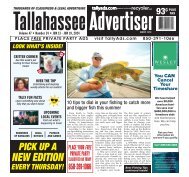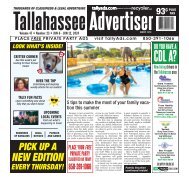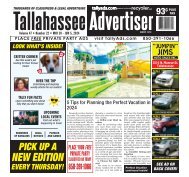TLA42_AllPages
You also want an ePaper? Increase the reach of your titles
YUMPU automatically turns print PDFs into web optimized ePapers that Google loves.
CAPITOL RECAP<br />
FMCSA’s Drug and Alcohol Clearinghouse program is designed<br />
to improve road safety by identifying drivers who are barred<br />
from driving commercial vehicles due to drug violations.<br />
• Drivers who respond to employer consent requests or would like to<br />
view their clearinghouse record when applying for a job; and<br />
• Substance-abuse professionals who report on the completion of<br />
driver initial assessments and driver eligibility for return-to-duty testing<br />
for violations committed on or after Jan. 6, 2020.<br />
There is no cost for registration. Commercial drivers are not required<br />
to immediately register for the clearinghouse but will need to register to<br />
respond to an employer’s request for consent prior to a pre-employment<br />
query or other full query being conducted. In addition, employers must be<br />
registered during the first year of implementation to ensure they are able<br />
to conduct the required annual query on all employed drivers.<br />
Combatting drug abuse has been a top priority of the U.S. Department<br />
of Transportation and the Trump Administration. President Trump has<br />
brought attention to the nation’s opioid crisis by declaring it a nationwide<br />
public health emergency and has implemented critical federal initiatives<br />
to help reduce opioid abuse.<br />
For information about FMCSA’s clearinghouse program, including<br />
user brochures and instructional aids with step-by-step registration<br />
instructions, visit clearinghouse.fmcsa.dot.gov.<br />
$1 TRILLION PROPOSED FOR<br />
INFRASTRUCTURE BUDGET<br />
The 138-page proposed fiscal-year 2021 budget issued by President<br />
Donald Trump’s Administration earlier this year proposes to reauthorize<br />
surface transportation funding to the tune of $810 billion over the next<br />
decade, along with an additional one-time payment of $190 billion to<br />
support a broad mixture of “infrastructure investments” across a range<br />
of industrial sectors.<br />
That would add up to more than $1 trillion in direct federal<br />
transportation and infrastructure funding between 2021 and 2030. This<br />
represents a “distinct departure” from the Administration’s 2018 outline,<br />
which sought to leverage $200 billion of direct federal funding into<br />
$1 trillion in overall investment with state/local and private contributions,<br />
according to an article in the Journal, the official publication of the<br />
American Association of State Highway and Transportation Officials<br />
(AASHTO).<br />
In a related development, published reports said the Trump<br />
Administration proposed cutting billions in discretionary spending in<br />
next year’s Department of Transportation (DOT) budget, while also<br />
calling for broad increases in spending throughout the next decade, a<br />
disconnect that left some in Congress and outside groups struggling to<br />
interpret the Administration’s intentions.<br />
As for the infrastructure proposal, the DOT said with the expiration of<br />
the Fixing America’s Surface Transportation (FAST) Act in September,<br />
the time to take bold action to address these and other challenges is now.<br />
“Building on the foundation provided in the FAST Act, the<br />
Administration’s funding proposal would largely grow by almost 4%<br />
annually through fiscal year [FY] 2030 … that will provide states and<br />
other entities with dependable and predictable funding for an entire<br />
decade,” a DOT spokesperson said.<br />
Near term, that translates into an $89 billion budget request for DOT<br />
FY 2021 funding — a nearly 2% increase above FY 2020 appropriations,<br />
of which $64 billion would come via the Highway Trust Fund (HTF).<br />
The Administration noted, however, that its request for $21.6 billion in<br />
discretionary transportation budget authority for FY 2021 is a $3.2 billion,<br />
or 13%, decrease from what was enacted for FY 2020.<br />
An analysis of the budget proposal by AASHTO policy staff noted<br />
that such fiscal proposals by the White House represent “the traditional<br />
first step” in budget negotiations with Congress toward final FY 2021<br />
appropriations measures.<br />
The proposed DOT FY 2021 budget cuts discretionary spending<br />
by 13%, including deep reductions in spending on Amtrak and airport<br />
grants. It also cuts more than $2 billion in highway infrastructure funds.<br />
DOT’s Acting Undersecretary Joel Szabat pointed to the deep shortfall<br />
in the HTF, which covers road and transit projects nationwide.<br />
The HTF’s main source of revenue, the gas tax, has failed to keep up<br />
with inflation or national needs.<br />
As it always has been, the argument over whether to raise the gas tax to<br />
replenish the HTF remains a major sticking point in the discussion about<br />
how to fund any infrastructure plan.<br />
Tolls and a vehicle-miles-traveled tax are other funding options that<br />
have been discussed within the circle of transportation stakeholders.<br />
“We estimate that there’s $261 billion in additional Highway Trust<br />
Fund cash that’s required to support the Administration’s proposal over<br />
10 years,” shared Szabat.<br />
The $1 trillion infrastructure-improvement plan presented by<br />
President Donald Trump would rely entirely on federal funding<br />
with no tax increases.<br />
10 TRUCKLOAD AUTHORITY | www.Truckload.org TCA 2020

















